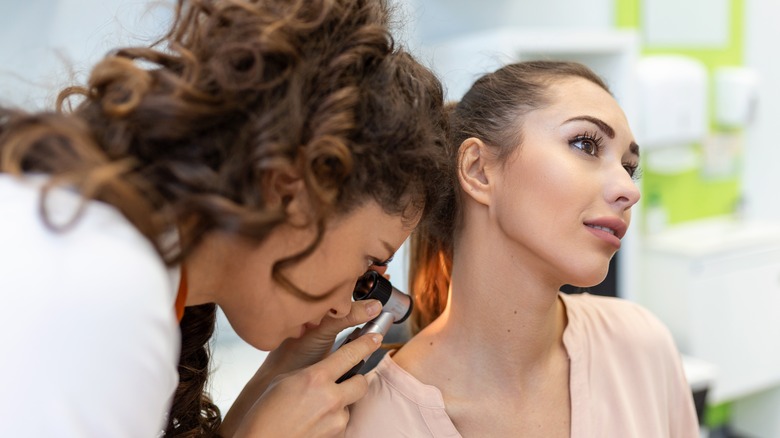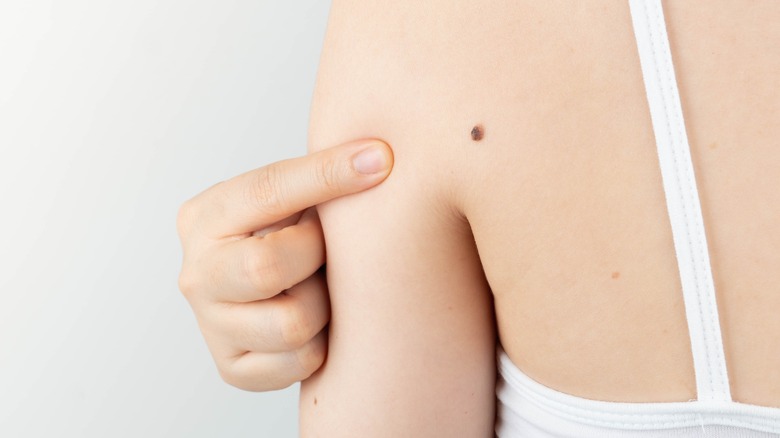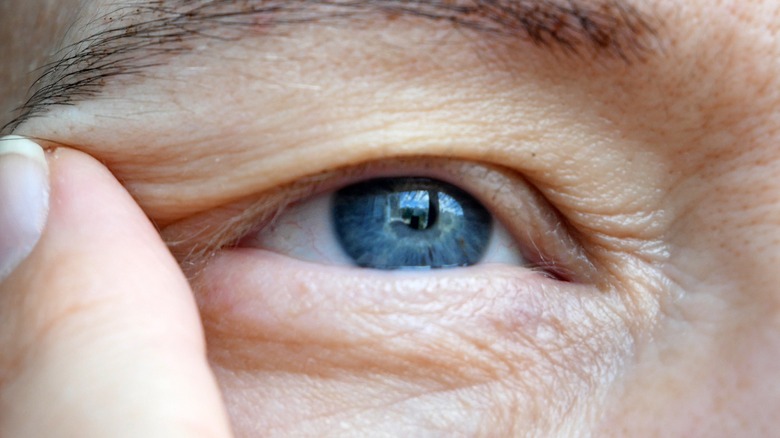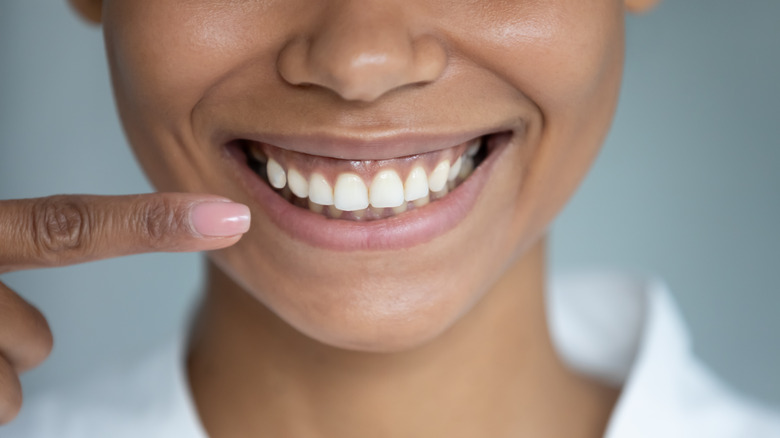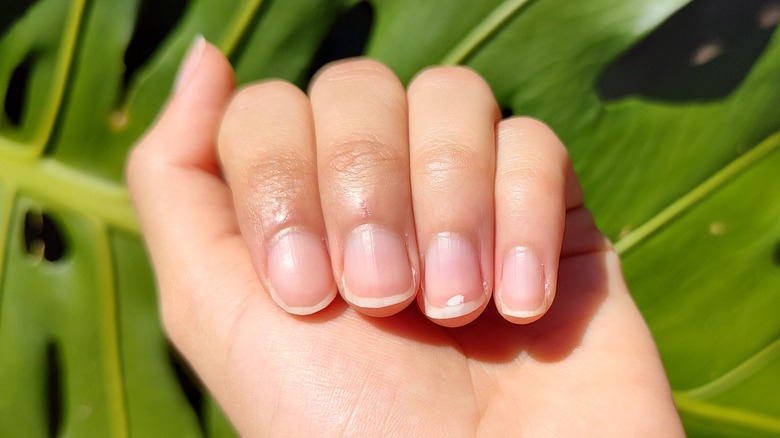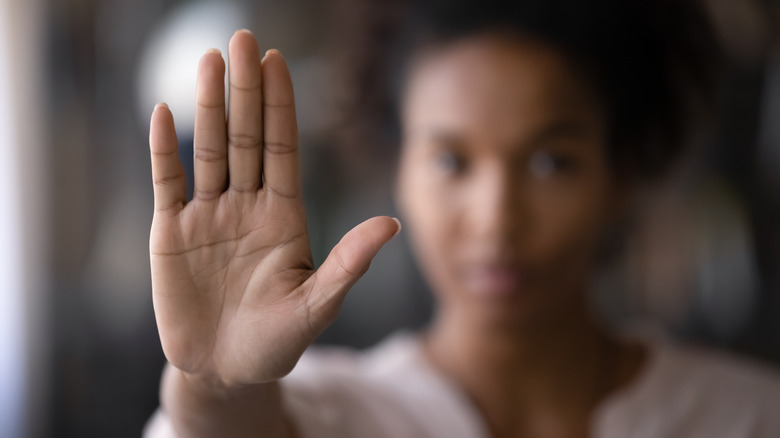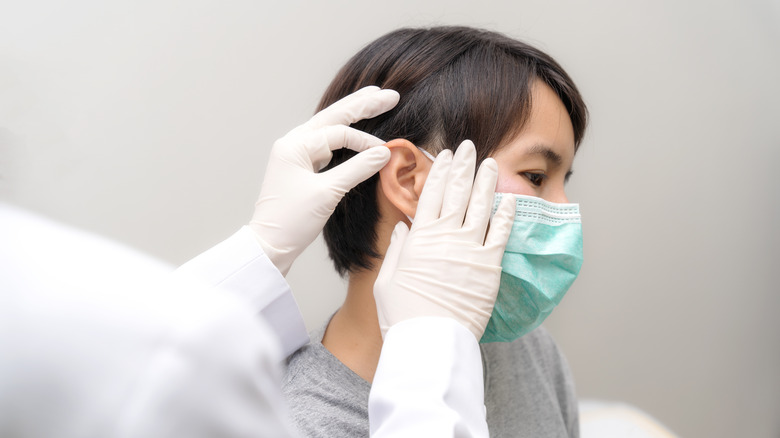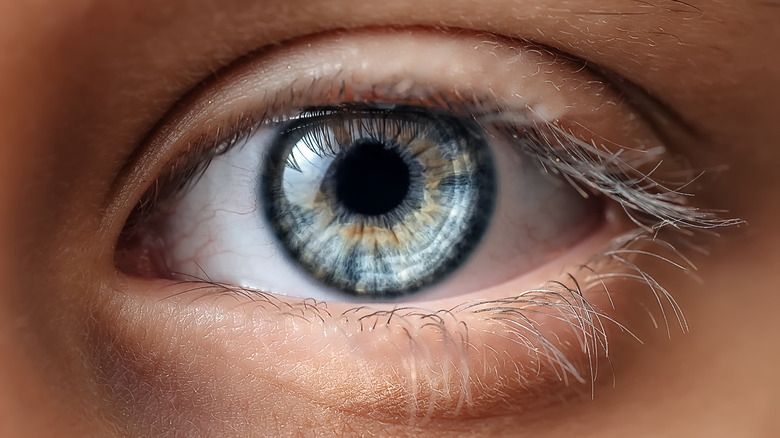12 Unexpected Places You Can Get Skin Cancer
It's easy to forget that your skin is the biggest organ you have, with roughly 16% of your entire body made up of skin (per Healthline). Like all of your organs, your skin performs an essential function, protecting the rest of your body from damage and bolstering your immune system. But, as with your organs, the skin is susceptible to damage and a variety of medical conditions, and skin cancer is one of them. Skin cancer affects around 20% of all people before the age of 70 in the United States, and is more commonly diagnosed than any other cancer, according to the Skin Cancer Foundation. And with almost 10,000 Americans discovering that they have skin cancer every day, you must keep on the lookout for it.
Perhaps because skin cancer is linked to sun damage, though, it's easy to assume that the only place you'll get the condition is in areas that are regularly exposed to UV rays. But that's far from the case. "Anywhere you have skin, you can get skin cancer," says dermatologist Anna Axelson (via Henry Ford Health). And skin cancer can show up in places on the body that you might not expect. Let's take a look at some of them.
The different types of skin cancer
When discussing skin cancer, it's vital to remember that it's not just one condition. The term "skin cancer" refers to a group of skin cells that have grown abnormally, which can then deepen and become more severe over time — but these cancers can come in several different types, according to the American Academy of Dermatology Association. The most frequently-occurring skin cancer is basal cell carcinoma (BCC). Generally more common in people with fair skin, BCC appears as a small round growth or discolored patch and is often a result of continual sun exposure. Squamous cell carcinoma, or SCC, is also a relatively common type of skin cancer, and also occurs in areas where sun exposure is frequent. Both BCC and SCC can deepen over time, and may cause damage to body parts below the skin, like your nerves and bones. SCC can also be heralded with a precursor called actinic keratosis, a precancerous skin growth that can develop into something more serious.
Looking out for melanoma, one of the more profound types of skin cancer is also essential. Generally appearing as a dark spot or patch, this skin cancer can frequently develop within a pre-existing mole. Treating melanoma early is vital to prevent further complications.
Your scalp
You might assume that your scalp is relatively safe from skin cancer. After all, unless you have less hair, surely your flowing locks will keep the skin on your head protected from sun damage, right? Well, you might be surprised to hear that's not entirely the case. "The scalp is actually a common site for melanomas," says Dr. Laura Farrington, oncologist, Cancer Treatment Centers of America (via Cancer Treatment Centers of America). The scalp is frequently exposed to the sun, even if you have hair covering your head, and this can lead to skin cancer that can be difficult to spot, according to Healthline. Skin cancers can also form on your scalp if you use a tanning bed regularly, or if you've had radiation therapy around your scalp, head, or neck.
That's why protecting your scalp when you go out in the sun is vital. Ensure that you're wearing a hat wherever possible, and apply sunscreen to any areas that are particularly exposed to UV rays. It's also important to check your scalp regularly for any signs of sun damage, and to ask your doctor to do the same, Farrington says.
Your eyelids
What's the one spot that you forget to cover when you're applying sunscreen to your face? If you said your eyelids, you might be in good company. The eyelids are usually not your go-to spot to put sunblock on, but doing so is essential since as many as 10% of all skin cancers occur on this small skin area, explains Sharecare. This is because unlike other parts of the body, the skin on your eyelids is especially delicate, and this means it's more likely to become damaged.
The problem is, though, that treating skin cancer on the eyelids is potentially more difficult than in other areas. "The eyelids are particularly scary when you talk about having surgery [to treat skin cancer]," says pathologist John Turner, Commonwealth Laboratory Consultants (via Sharecare). It's useful, therefore, to practice preventative measures as much as possible. Using UV-protection sunglasses can be an effective way to protect your eyes, Turner explains, or you might want to consider using a moisturizer that has an in-built sunblock. This may be preferable to putting sunscreen directly onto your eyelids, as that can cause your eyes to sting and become irritated.
The soles of your feet
How often do you look at the soles of your feet? Probably not that often, right? We understand why: It's one of the parts of the body that's most awkward to take a look at. But we'd advise you to take a glance at them now and then, as the soles of your feet are just as susceptible to developing melanoma as your other body parts, explains the American Academy of Dermatology Association. While the soles of your feet may not be as exposed to sunlight often, melanoma can also be triggered by an injury to the foot, and over time this can develop into something more serious.
It's worth bearing in mind, too, that melanoma has several different appearances. In addition to looking like a dark, mole-like growth, melanoma can also appear as a pinkish-red patch or as a sore that doesn't heal. Remember that melanoma can also grow on any part of your feet, including the sides of your foot and in between your toes. If you suspect that you're growing melanoma, you must get in touch with your doctor immediately, so that they can give you the care you need.
Your lips
It's important to remember that the lips are part of your skin too, and just like other parts of the skin, they're susceptible to cancer. In fact, lip cancer is the most frequently-occurring type of oral cancer, with roughly 40,000 incidences annually in the United States, most commonly in older adults and especially males over 50, the Cleveland Clinic states. As with other skin cancers, lip cancer can be prompted by continuous sun exposure, and can initially be mistaken as a cold sore due to being similar in appearance.
Luckily, many lip balms are made with SPF incorporated into their formulations, so it's highly advisable to use one of these whenever you're in the sun. It's also important to remember that smoking and alcohol use can be risk factors for lip cancer, with smoking, in particular, directly related to a high proportion of lip cancer cases. The good news is that, unlike some other body parts, you generally see your lips quite a lot, so it's easier to spot when there's a discoloration or sore that could be cancer. If you do spot anything out of the ordinary, though, it's important to act fast.
Your genitals
It's easy to get shy when discussing genital health, but it's vital to do so if you think that there's an issue. Especially if you suspect that you could be experiencing skin cancer in your genital area. While less common, vaginal melanoma can occur despite the area not being exposed to the sun regularly, and is usually more likely in older women, according to Cancer Research UK. Squamous cell carcinoma may also appear on the penis and particularly the foreskin and glans, leading to penile cancer (per the American Cancer Society).
So, if you suspect that your genital area might have skin cancer, it's important to speak up. "Don't be afraid to ask your gynecologist or dermatologist to check a spot in that area. We're used to seeing it," says dermatologist Anna Axelson (via Henry Ford Health). Remember that the consequence of not getting it checked is usually less preferable than the awkwardness of asking in the first place. "I always tell my patients, 'if you're not sure, I'd rather you get it checked out and it be nothing than not get it checked out and have it be skin cancer,'" Axelson adds.
Under your fingernails
Hey, folks, we're gonna let you in on a little secret. Your nails? They're skin. Uh-huh. Well, technically, anyway. They're known as skin appendages and are constructed from skin cells, as are your nail beds (per the Institute for Quality and Efficiency in Health Care). And just like skin elsewhere, the areas under your fingernails can be affected by skin cancer, via something called a "subungual melanoma," explains WebMD. While any of your 20 nails can be affected by subungual melanomas, it's the bigger ones, like your thumbs and big toes, that bear the most risk of developing them.
Generally, subungual melanomas are less linked to sun damage, and instead develop thanks to trauma to the nail, which then develops into melanoma over time. Like other melanomas around your body, subungual melanomas are dark in appearance, and usually, show up as dark streaks under your nails, or a generally dark discoloration (via StatPearls Publishing). Subungual melanomas can also lead to further damage to the nail and cause it to split or become inflamed. Luckily, subungual melanomas are pretty uncommon, but any discoloration you notice under your fingernails should be discussed with a doctor as soon as possible.
Behind the ears
Your mom may have always told you to wash behind your ears, but we'd recommend you check behind them regularly, too. Skin cancer can occur behind your ears, as well as on the ear itself, thanks to sun damage (per Sharecare). Skin cancer behind the ears may be squamous cell carcinoma and may appear as a hard, pink lump, or a sore that doesn't get better over time (per Cancer Research UK). Cancer can also affect other parts of the ear, like the ear canal and middle and inner sections.
As well as applying sunscreen to the area behind your ears, it can also be worth considering your style of headwear. Try using a hat with a wide brim instead of a baseball cap that only covers the front of your face, to maximize your protection from the sun, according to pathologist John Turner, Commonwealth Laboratory Consultants (via Sharecare). When it comes to checking for skin cancer behind the ear, you can either use a mirror to check yourself and "There's nothing wrong with using a buddy system," advises Turner. Grab your best pal, and ask them to have a look, returning the favor for them. Hey, we can think of stranger ways to bond with your friends!
The palms of your hands
Sometimes, skin cancer may be hiding in plain sight. Such is the case with acral lentiginous melanoma, a form of melanoma that occurs on the extremities of your body, including the palms of your hands, as well as your nails and feet (per Medical News Today). Especially common in African American individuals, acral lentiginous melanoma (ALM) may be responsible for up to 3% of melanomas across the board, and can be similar in appearance to other melanomas, showing up as a black or dark mark on your palms or the inside of your hand. ALM can also appear as a growth that may change in size or shape, or an especially thick patch of skin.
It's worth remembering that while ALM marks may not seem large in diameter, they can grow into the body itself, and create complications and potential damage. Generally, your doctor will attempt to treat the melanoma by removing it via surgery, along with any tissue that may have been affected by its growth. If the surgery is not enough to tackle the cancer, or if surgery isn't possible, a course of chemotherapy may be recommended and administered.
Your butt
When we say that skin cancer can occur anywhere that you have skin, we really do mean it. And that includes on your butt. Your buttocks are susceptible to basal cell carcinoma, the most common type of skin cancer, and can require treatment to deal with it, as research published in SkinMed discusses.
Cancer that occurs on your butt is pretty rare, however, and as the SkinMed research points out, only 28 patients for basal cell carcinoma of the buttocks had been reported in clinical research as of 2018. Additionally, the outcomes for patients who had basal cell carcinoma on their buttocks — after treatment that removed the carcinoma — were very good, with a repeat of cancer generally not noted. Bear in mind, however, that pain around the buttocks and anus may not be basal cell carcinoma, but a sign of anal cancer, as Healthline discusses. People who experience anal cancer may also experience symptoms like itching or swelling around the anus, bleeding in the anal area, or a change in your poop.
Inside your ears
Skin cancer can manifest around some of the smallest areas in your body, and the inside of your ears can be one of them. As you might expect, cancer inside the ear can be tricky to spot and can occur when you ignore a cancerous growth that originally appears on your outer ear, as WebMD explains. While cancer inside the ear can start small, over time it can grow, and cause a range of symptoms including numbness in and around your face (per Cancer Research UK).
The stage that the cancer's at will determine the type of treatment that can be applied to tackle it. Surgery can be an option, during which your doctor may have to remove certain parts of your ear, including the middle or inner ear, the temporal bone, or the lymph nodes in the area. Radiotherapy and chemotherapy could also be options for treatment, although it should be pointed out that chemotherapy is not necessarily a cure for cancer inside the ear, but may be used alongside or after other methods or as symptom relief.
Your tongue
While your tongue is primarily made of muscle, it has specialized skin cells on it too, similar to the ones that are found in the gut (per research published in the Annual Review of Physiology). And like all areas that have skin cells on the body, it's prone to getting skin cancer. The most frequent type of tongue cancer is squamous cell carcinoma, according to Healthline. Generally, this will appear as a discolored patch on your tongue that doesn't go away over time, an ulcer that doesn't cure, or may be flagged by other symptoms like numbness, pain, or a continuous sore throat.
Unlike many other parts of the body, the tongue isn't exposed to the sun, a traditional cause of skin cancer. So what prompts it? Drinking alcohol to excess and smoking are key causes, and HPV infection can also lead to tongue cancer (per Healthline). You may also be more likely to develop squamous cell carcinoma if you have a history of tongue cancer in your family, or if you don't practice good oral hygiene. It's also vital to make sure you eat a healthy diet, and to make regular trips to your dentist, as they'll likely be the first person (other than yourself) to notice if anything looks unusual.
Your eyes
Your eyes are as susceptible to developing cancer as other parts of your body and can be affected by certain types of melanoma (via WebMD). In the whites of your eyes, conjunctival melanoma can develop, usually indicated by a darker spot or growth in your eye itself. Whole conjunctival melanoma is uncommon — it's also incredibly serious, and may elude treatment by appearing in its first stages as just a red section of the eye that might look like regular conjunctivitis or a simple discoloration (per the American Academy of Ophthalmology). Conjunctival melanoma may spread to other parts of the body, causing further complications. It may be diagnosed by your doctor performing a biopsy of part of your eye tissue.
Cancer that occurs in the iris is more common than conjunctival melanoma but (like that type of cancer) may also spread elsewhere. Called "intraocular" or "uveal" melanoma, it may appear as a dark area in the blue, green, or brown of your eye. Melanoma in your iris may be tackled by using surgery, or less frequently through the use of radiotherapy, as the American Cancer Society explains. If the melanoma becomes too big, doctors may have to consider removing your eye entirely.
Preventing skin cancer
The entire prevention of skin cancer over your whole body may not be possible, but the good news is that skin cancer is clearly linked to one specific factor: Sun damage. The majority of skin cancers are a result of UV ray exposure, which damage and changes the structure of your skin cells, heightening the risk of cancer development (per the Centers for Disease Control and Prevention).
As such, the most sensible thing to do is to be aware of how much you're exposing your skin to the sun, and taking measures to limit it as much as possible. Ensure that you cover exposed skin, especially between the hours of 10 a.m. and 4 p.m. when the sun is generally highest in the sky and UV rays are most concentrated — and make sure you're regularly applying a higher-strength sunscreen. You should take extra measures to protect the more sensitive areas of skin on your body, like your ears and eyelids, wearing a wide-brimmed hat if you have one.
Remember, too, that while having a deep tan may look and feel good, using sun beds to achieve that bronzed look means that you're exposing your skin to high levels of UV radiation. Doing so will make your chances of skin cancer more likely, so limit your time spent using indoor sun beds, avoiding them entirely if possible.

